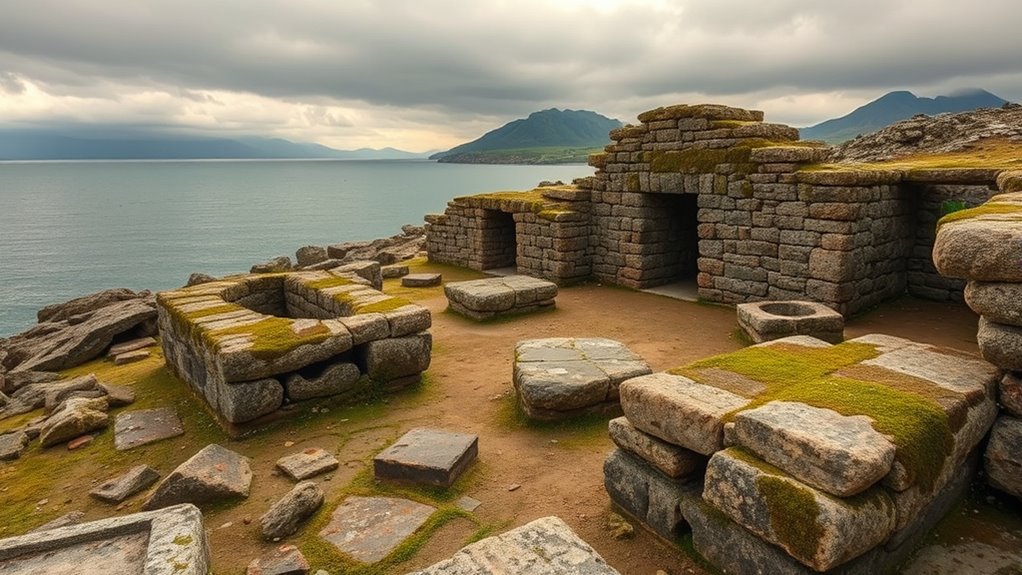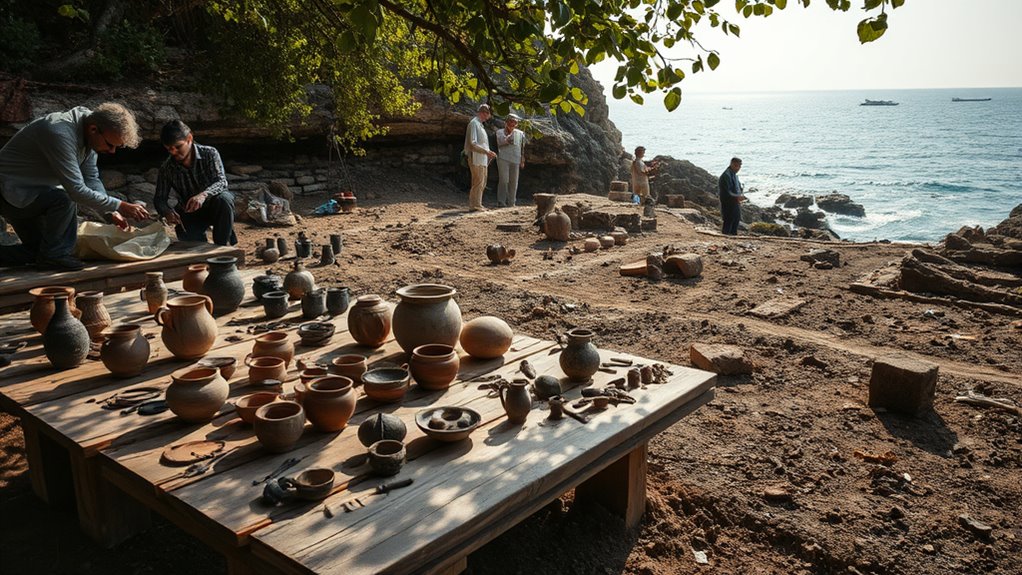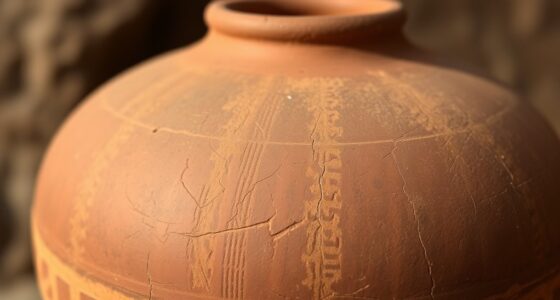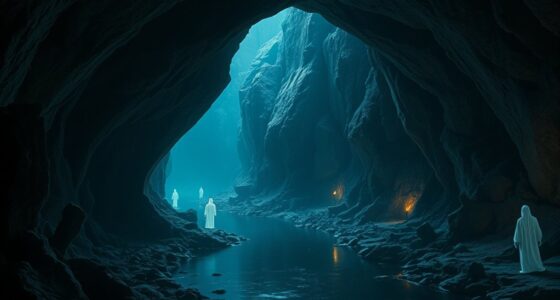The Golden Fleece Expedition hints at early trade networks around the Black Sea that connected cultures and exchanged valuable goods like textiles, metals, and exotic animals. Archaeological finds, shipwrecks, and ancient artifacts show these routes existed long before Greek myths emerged, symbolizing the region’s importance as a center of commerce and cultural exchange. The myth may reflect real trade activities and treasured objects, with more clues revealing how myth and history intertwine as you explore further.
Key Takeaways
- Archaeological finds along the Black Sea reveal early trade routes and artifacts linking the region to proto-historical economic systems.
- The myth of Jason’s Golden Fleece may symbolize real valuable commodities traded or symbolic relics in ancient maritime networks.
- Shipwrecks and exotic artifacts support the Black Sea’s role as a hub in early trade routes predating classical narratives.
- The region’s trade networks facilitated cultural exchange and may have inspired legendary stories like the Argonauts’ expedition.
- The Golden Fleece embodies the interplay between myth and material culture, reflecting ancient perceptions of wealth and divine favor in trade.

To answer that, you explore archaeological evidence. Excavations along the Black Sea coast have uncovered remnants of ancient trade routes, storage facilities, and artifacts that hint at sophisticated economic systems. These findings suggest that the region was a hub for exchange, possibly involving valuable textiles, metals, or even exotic animal products that might have inspired the myth. Some archaeologists propose that the fleece could have been a symbol for a rare, prized commodity—perhaps a special kind of wool or a ceremonial object—that held immense cultural significance. The discovery of ancient shipwrecks laden with trade goods further supports the idea that this area was a vital link in early trade networks, possibly predating the classical Greek narratives. Additionally, trade route networks likely facilitated the movement of goods and ideas across the region, further emphasizing its importance in proto‑history.
As you piece together this puzzle, you notice that the Black Sea’s role as a trade conduit predates written history, blending myth with reality. The myth of Jason and the Argonauts might reflect real journeys undertaken by traders seeking valuable resources or establishing alliances. These ancient expeditions could have left behind tangible clues—such as artifacts or ship remains—that align with the stories passed down through generations. The notion that the Golden Fleece might have been a real object, perhaps a ceremonial or symbolic relic, fuels your intrigue. You realize that understanding the mythical origins alongside the archaeological evidence helps illuminate how ancient peoples perceived wealth, divine favor, and their own history.
Ultimately, your exploration reveals that the Golden Fleece Expedition is more than just a myth; it’s a window into the proto-history of Black Sea trade. The intertwining of legend and archaeology paints a vivid picture of a region rich in cultural interactions, where stories of divine treasures could have roots in tangible economic realities. This blend of myth and material culture invites you to contemplate how ancient civilizations understood their world—through stories that carried deep social and spiritual meanings, shaped by the very trade routes that connected distant peoples. The pursuit of the Golden Fleece continues to inspire curiosity, bridging myth, history, and archaeology into a compelling narrative of human ingenuity and discovery.
Frequently Asked Questions
What Were the Long-Term Impacts of the Golden Fleece Expedition?
The long-term impacts of the Golden Fleece expedition shaped your understanding of mythical narratives and leadership dynamics, highlighting how legendary stories influence cultural identity. This expedition fostered trade connections across regions, promoting economic growth and cultural exchange. It also exemplified the importance of strategic leadership, inspiring future explorers and leaders. Over time, these stories reinforced societal values, emphasizing bravery and cunning, which continue to resonate in modern storytelling and leadership models.
How Did the Expedition Influence Subsequent Black Sea Trade Routes?
Did you know that over 60% of Black Sea trade routes today trace back to ancient maritime navigation innovations? The expedition profoundly influenced trade network development, establishing key routes that connected Crimea, the Aegean, and Anatolia. This expansion facilitated increased trade, cultural exchange, and the spread of technologies, laying the groundwork for subsequent civilizations to develop more sophisticated maritime navigation techniques and strengthen Black Sea trade networks for centuries to come.
Were There Any Significant Cultural Exchanges During the Expedition?
During the expedition, you’d see significant cultural exchanges, as mythical alliances fostered connections between diverse groups. These interactions led to the transfer of cultural artifacts, enriching local traditions. You’d notice how shared myths and alliances shaped relationships, encouraging trade and cooperation. These exchanges didn’t just influence economy; they also created a tapestry of cultural understanding, leaving traces that highlight the importance of intercultural contact in ancient Black Sea history.
What Archaeological Evidence Supports the Expedition’s Historical Accounts?
Imagine uncovering mythical artifacts that echo stories from ancient inscriptions, revealing a history hidden beneath layers of time. Archaeological evidence like these artifacts and inscriptions supports the expedition’s accounts by confirming trade routes and cultural exchanges in the Black Sea region. These finds act as tangible links to the past, showing that the stories of the Golden Fleece are rooted in real interactions, not just myth.
Did the Expedition Encounter Any Hostile Civilizations or Conflicts?
You might wonder if the expedition faced hostile civilizations or conflicts. It’s likely that they encountered tribal conflicts and maritime skirmishes along the Black Sea coast. These encounters could have involved local tribes resisting outsiders or territorial disputes, leading to skirmishes at sea or on land. Such conflicts would have been common during early trade and exploration, making hostile encounters a plausible part of their journey.
Conclusion
So, you’ve uncovered the Golden Fleece Expedition’s secrets—maybe it was just an elaborate stunt, or perhaps the ancient Black Sea traders knew more than we give them credit for. Either way, it seems history’s treasure hunt was less about fleece and more about who could spin the best yarn. As you close this chapter, remember: sometimes, the real treasure is the mystery itself—hidden beneath layers of myth, trade, and a touch of good old-fashioned legend.








